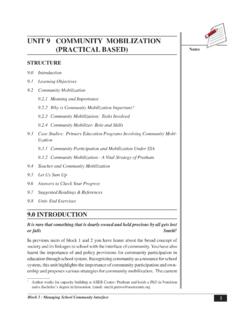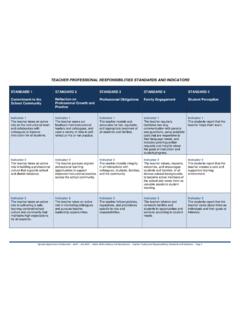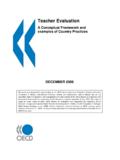Transcription of Strong School–Community Partnerships in Inclusive …
1 9 < strong >schoolstrong > < strong >communitystrong > Journal, 2015, Vol. 25, No. 2 Available at < strong >Strongstrong > < strong >schoolstrong > < strong >communitystrong > < < strong >Strongstrong > >Partnershipsstrong >Strongstrong > > in < < strong >Strongstrong > >Inclusivestrong >Strongstrong > > Schools Are Part of the Fabric of the Count on Them Judith M. S. Gross, Shana J. Haines, Cokethea Hill, Grace L. Francis, Martha Blue-Banning, and Ann P. TurnbullAbstractSchool < strong >communitystrong > < < strong >Strongstrong > >Partnershipsstrong >Strongstrong > > play an essential role in successful schools, often providing supports and resources to meet staff, family, and student needs that go beyond what is typically available through < strong >schoolstrong > . Reciprocally, commu-nity partners benefit from their relationships with schools, including learning about schools < < strong >Strongstrong > >Inclusivestrong >Strongstrong > > culture. To better understand < strong >Strongstrong > < strong >communitystrong > part-nerships and what fosters their development, we conducted focus groups with < strong >communitystrong > partners of five schools. The first main finding presented in this article is that these schools have a variety of partners and < < strong >Strongstrong > >Partnershipsstrong >Strongstrong > > , but all < < strong >Strongstrong > >Partnershipsstrong >Strongstrong > > are reciprocal in that they are mutually beneficial.
2 The second set of findings presented include the < strong >schoolstrong > factors that were facilitators of successful < strong >schoolstrong > < strong >communitystrong > < < strong >Strongstrong > >Partnershipsstrong >Strongstrong > > : < strong >Strongstrong > < strong >schoolstrong > leadership, an invit-ing < strong >schoolstrong > culture, educator commitment to student success, and the ability to collaborate and communicate with < strong >communitystrong > partners. The < strong >communitystrong > partners in many of these schools emphasized how the culture of including all students and providing all students with an excellent education profoundly in-fluenced how they perceived disability and how they used their new knowledge in other settings. Implications for practice and future research are Words: inclusion, < strong >schoolstrong > < strong >communitystrong > < < strong >Strongstrong > >Partnershipsstrong >Strongstrong > > , < < strong >Strongstrong > >Inclusivestrong >Strongstrong > > culture, dis-ability, collaboration, communication, external organizationsSCHOOL < strong >communitystrong > JOURNAL10 IntroductionWillems and Gonzalez-DeHass (2012) described < strong >schoolstrong > < strong >communitystrong > part-nerships as meaningful relationships with < strong >communitystrong > members, organizations, and businesses that are committed to working cooperatively with a shared re-sponsibility to advance the development of students intellectual, social, and emotional well-being.
3 < strong >schoolstrong > < strong >communitystrong > < < strong >Strongstrong > >Partnershipsstrong >Strongstrong > > can impact student success and post- < strong >schoolstrong > outcomes as well as positively influence and benefit the < strong >communitystrong > in return. Auerbach (2010) characterized authentic < < strong >Strongstrong > >Partnershipsstrong >Strongstrong > > as respectful alliances among educators, families, and < strong >communitystrong > groups that value relationship building, dialogue, and power sharing as part of a socially just, democratic < strong >schoolstrong > (p. 729). The development of authentic, trusting rela-tionships is germane to establishing effective < strong >schoolstrong > < strong >communitystrong > involvement in schools is a critical component for student achievement (Anderson, Houser, & Howland, 2010; Bryk, 2010; Coleman, 1988; McAlister, 2013; Sanders, 2006). Research shows schools that develop < strong >Strongstrong > < strong >communitystrong > < < strong >Strongstrong > >Partnershipsstrong >Strongstrong > > have (a) a higher percentage of students per-forming on grade level (Sheldon, 2003), (b) increased parental volunteerism (Anderson et al.)
4 , 2010), (c) supported < strong >schoolstrong > reform efforts (McAllister, 2013), (d) increased student test scores (Blank, Melaville, & Shah, 2003; Sheldon, 2007), (e) increased student attendance rates (Sheldon, 2003, 2007; Sheldon & Epstein, 2004), and (f ) connections for students to learning opportunities outside of < strong >schoolstrong > (Blank et al., 2003). Because of their < strong >Strongstrong > influence on stu-dents, families, and schools, trusting < strong >communitystrong > < < strong >Strongstrong > >Partnershipsstrong >Strongstrong > > are an integral feature of the Schoolwide Integrated Framework for Transformation (SWIFT). SWIFT is an evidence-based theoretical framework for a fully braided, in-clusive educational delivery system that extends beyond the < strong >schoolstrong > to include families and < strong >communitystrong > , as well as state and district policies and practices (Mc-Cart, Sailor, Bezdek, & Satter, 2014; Sailor & Roger, 2005; Sailor et al., 2006). We define evidence-based as practices drawn from research studies that have been replicated numerous times with defined, measurable outcomes indicating effectiveness.
5 < < strong >Strongstrong > >Inclusivestrong >Strongstrong > > schools educate all students in learning environments that practice equity-based inclusion of all children, where every student is valued as a member of his or her neighborhood < strong >schoolstrong > and is provided the sup-ports needed to achieve social and academic success. The SWIFT framework integrates five evidence-based domains as the foundation of effective < < strong >Strongstrong > >Inclusivestrong >Strongstrong > > < strong >schoolstrong > transformation (see Figure 1): (a) administrative leadership ( , Ainscow & Sandhill, 2010; Burrello, Hoff-man, & Murray, 2005; Marzano, Waters, & McNulty, 2005; Waldron & McLeskey, 2010), < < strong >Strongstrong > >Partnershipsstrong >Strongstrong > > IN < < strong >Strongstrong > >Inclusivestrong >Strongstrong > > SCHOOLS11(b) multi-tiered system of support ( , Bradshaw, Mitchell, & Leaf, 2010; Lane, Oakes, & Menzies, 2010; Sugai, Simonsen, Bradshaw, Horner, & Lewis, 2014), (c) integrated educational framework ( , Hang & Rabren, 2009; O Day, 2002; Wenger, 2000), (d) family and < strong >communitystrong > engagement ( , Anderson-Butcher et al.)
6 , 2008; Bryk, 2010; Lawson & Sailor, 2000), and (e) < < strong >Strongstrong > >Inclusivestrong >Strongstrong > > policy structure and practice ( , Burrello, Sailor, & Kleinham-mer-Tramill, 2013; Kozleski & Smith, 2009). While the SWIFT framework is appropriate for any < strong >schoolstrong > (O Rourke, 2014; Ryndak, Jackson, & White, 2013), it is especially beneficial for trans-forming schools that struggle with low achievement, high rates of problem behavior, and segregated delivery of specialized services. As such, the Department of Education, Office of Special Education Programs (OSEP) es-tablished the National Center on Schoolwide < < strong >Strongstrong > >Inclusivestrong >Strongstrong > > Reform, referred to as SWIFT Center, to provide intensive technical assistance to K 8 urban, rural, and high need schools, along with their districts and state education agencies, to improve outcomes for students with disabilities while transforming schools to positively impact all students ( Department of Education, 2012).
7 SWIFT Center defines the domain of family and < strong >communitystrong > engagement as < strong >Strongstrong > , ongoing, collaborative working are developed with consideration of the unique culture of the < strong >communitystrong > [and] allow for stakeholder input in the design, implementation, evaluation, and continuous improvement of the system (SWIFT Center, 2013, p. 3). We define the fea-ture of trusting < strong >communitystrong > < strong >schoolstrong > < < strong >Strongstrong > >Partnershipsstrong >Strongstrong > > as < < strong >Strongstrong > >Partnershipsstrong >Strongstrong > > contributing to positive student outcomes and occurring when schools work collaboratively with < strong >communitystrong > members, agencies, organizations, businesses, and industry around common goals, resulting in (a) direct participation by < strong >communitystrong > rep-resentatives in < strong >schoolstrong > leadership, and (b) enhanced < strong >communitystrong > resources. In other words, < < strong >Strongstrong > >Partnershipsstrong >Strongstrong > > between schools and < strong >communitystrong > members benefit students, families, schools, communities, or any combination of these parties (Sanders, 2006).
8 Understanding what kinds of < strong >schoolstrong > < strong >communitystrong > < < strong >Strongstrong > >Partnershipsstrong >Strongstrong > > are typically a part of successful schools and how schools foster and develop those < < strong >Strongstrong > >Partnershipsstrong >Strongstrong > > is important to the research of SWIFT Center as we seek to support schools in developing their own < strong >schoolstrong > < strong >communitystrong > < < strong >Strongstrong > >Partnershipsstrong >Strongstrong > > . This knowledge and understanding is also critical to the education field, as many states are undergoing budgetary constraints; both schools and communities may benefit from the resource sharing incurred from such < strong >communitystrong > JOURNAL12 Purpose of the Study and Research QuestionsTo inform SWIFT Center s development of its technical assistance process, we conducted a broad knowledge development study across six schools nomi-nated due to their implementation of one or more of the domains in the SWIFT framework (see Figure 1). The broad knowledge development study examined influencing factors in these schools as related to the SWIFT evidence-based do-mains.
9 Here we report on the analysis of the < strong >communitystrong > < strong >partnershipstrong > data from the larger study. Specifically, we sought to explore the following questions: (a) What kinds of < strong >communitystrong > < < strong >Strongstrong > >Partnershipsstrong >Strongstrong > > do successful schools develop?(b) What factors support the development of < strong >Strongstrong > < strong >communitystrong > < < strong >Strongstrong > >Partnershipsstrong >Strongstrong > > in these schools? Figure 1. Schoolwide Integrated Framework for Transformation (SWIFT)Domains and FeaturesPARTNERSHIPS IN < < strong >Strongstrong > >Inclusivestrong >Strongstrong > > SCHOOLS13 MethodsThis knowledge development study was conducted as part of SWIFT s ap-preciative inquiry into < < strong >Strongstrong > >Inclusivestrong >Strongstrong > > schoolwide transformation (Cooperrider & Whitney, 2005). Appreciative inquiry is a strengths-based approach to sys-temic and organizational change that seeks to understand and value the best of what exists, imagine what could be possible, collaboratively plan for what we desire to be, and implement what will be.
10 By developing a greater under-standing of the successes and challenges faced in the schools nominated for this research, the goal was that the knowledge gained would inform the implemen-tation efforts among SWIFT partner states, districts, and schools undergoing systemic transformation into fully < < strong >Strongstrong > >Inclusivestrong >Strongstrong > > schools (Shogren, McCart, Lyon, & Sailor, 2015) and other schools seeking positive change. There were five lines of inquiry guiding the appreciative inquiry: classroom practices, teacher and administrator perspectives, student perspectives, fam-ily and < strong >communitystrong > partner perspectives, and supports for students with the most significant needs. The present article provides the findings of an analysis of the < strong >communitystrong > partner focus groups. We report the methods of participant selection, including (a) the selection of the schools identified as Knowledge Development Sites (for the remainder of the article referred to as KDS), (b) the demographics of the KDS, (c) the recruitment of participants for the communi-ty partner focus groups, and (d) the demographics of focus group of KDS Six < < strong >Strongstrong > >Inclusivestrong >Strongstrong > > elementary and middle schools were selected as KDS through a systematic nomination and screening process that included surveys, interviews, and site visits.
















